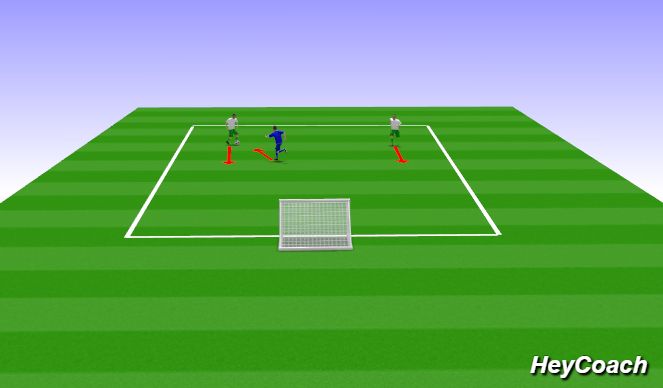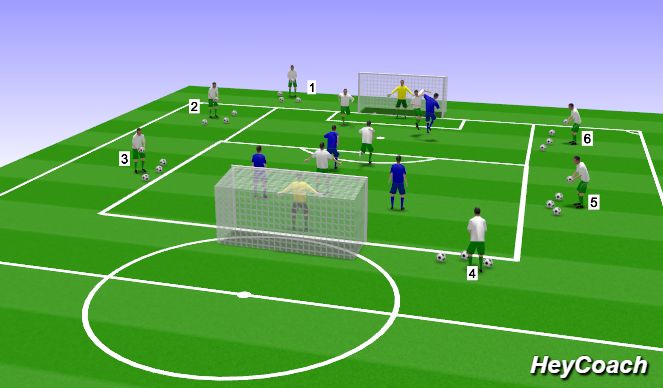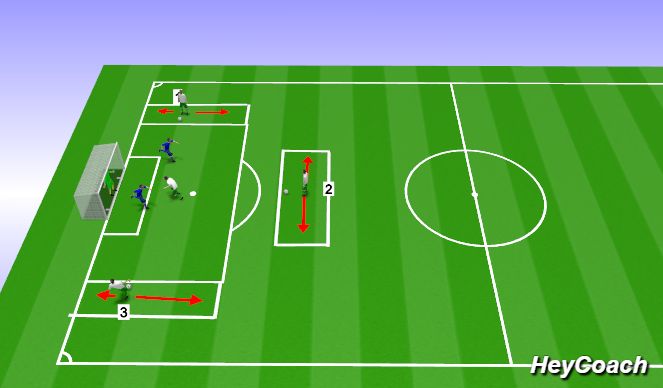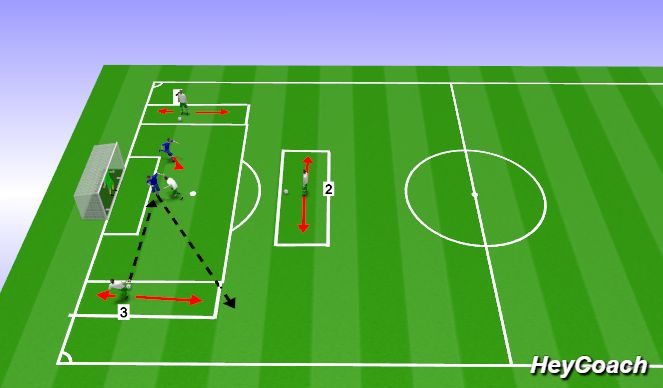
Defending Warm Up
Setup - Mark out an area of 25 x 6 - 8 yards. The size of the area can be adjusted to suit the age and
ability of the players. The structure of the practice is 2 attackers about 6 yards apart, with a
ball between them, who should pass the ball between themselves and try and get the ball over
the far line under control. There is one defender. The defender must shuffle quickly across to
the player receiving the ball and try and force the attacker outside and wide to try and delay
and slow the attacker down. The attackers should be instructed to initially be slightly passive
so that the defenders technique of how to delay attacks can be fully understood.
Coaching Points - 1. Defender to be on their toes, sharp and alert
2. If the opportunity presents itself to win or intercept the ball, the defender will need to make a decision on whether to take the chance
3. Whilst attackers are a long way from the end target line, the defender should back off and be
in a position to cover any ball that is played past them
4. The defender should adopt a body position that forces the defender down the line and makes it difficult to pass into the space behind them
5. The defender needs to recover goal side of the attackers
6.This will require a quick, sideways crab like movement, always looking at the ball
7. As the attackers get closer to the end line, the defender will need to get tighter and try and win or intercept the ball if they can.
Progressions - 1. Encourage attackers to play at a faster pace and with more realism
2. Position a small goal at the end line of the area, so the attackers have a focus to score into and the defender has something to defend
3. Play three or four attackers V two defenders
4. Progress the practice to a skill.
Other points - The defender must shuffle between the attackers and try and force the attacker away from goal and delay and slow the attack down. At first, because the attackers are 25 yards away from the target end line, the defender doesn’t have to get too tight to the attackers. It is important that the defender adopts a body position that forces the attacker outside and makes it difficult for them
to pass back to their attacking team mate. The objective for the defender is to adopt good lines of recovery and good body angles to delay and slow the attackers down. As the ball is transferred across again, the defenders line of recovery becomes important. They should recover goal side of the ball, again trying to force the attacker outside. As the attackers get closer to the end line, the defender should look to get tighter and to look to win or intercept the ball if they can.

Defending Game - Heading Practice
Setup - Mark out a pitch about 35 x 20 yards, although the size can be adjusted to suit the age and
ability of the players. The pitch should have two goals, with goalkeepers. Play a 2 – 1 – 1
formation. It is a free game but the coach should build in some sort of tactical shape to the
game but allow the players to rotate where required.
There are six servers with footballs, located around the perimeter of the pitch and numbered.
The servers can move up and down their areas to provide different angles and heights of
crosses and balls into the defensive area.
Encourage free play and the team in possession can pass the ball to any of the servers and the
defensive team must then adjust and organise for the thrown cross. If the ball goes out of play,
the coach can also call the number of a server and an area for the ball to be thrown into. The
defensive team then adjusts and organises to the serve into their area.
Coaching Points - 1. Communication between defenders and GK
2. Defenders work as a unit, one attacking the ball, the others providing cover
3. Start position in relation to where the ball is served from
4. Get in the line and attack the ball down the line of the cross
5. Timing of run and jump
6. Select relevant defensive heading technique
7. Protect the goalkeeper if they come for the cross
8. After defensive header, readjust and reorganise
9. Squeeze up the pitch if possible after the ball has been headed clear

Progression 1 - In free play, the ball is passed to server number two. The two defenders and the GK must adjust their position and defend the thrown cross into the area. It is important that the servers serve the ball accurately and throw the ball to the various key defensive areas, near post, far post and the middle of the goal. The attacker tries to score. In this instance the ball is thrown to the near post and the first defender gets in front of the attacker to head clear

Defending Crosses
Setup - Use the penalty area, extending the area to about 25 30 yards out. There are a total of 7 players, two defenders, a goalkeeper and one attacker. On the right and left hand side of the 18 yard area are two servers and another server in front of the penalty area, about 25 yards out. The servers are numbered, can move to vary the angle of serve and must serve the ball by throwing it. The coach calls which server will throw the ball to give the defenders and goalkeeper time to set themselves. The defenders and goalkeeper defend the crosses and the attacker tries to score.
Coaching Points - 1. Communication between defenders and GK
2. Defenders work as a pair, one attack the ball,one cover
3. Start position in relation to where the ball is served from
4. Get in the line and attack the ball down the line of the cross
5. Timing of run and jump
6. Select relevant defensive heading technique
7. After defensive header, readjust and reorganise
8.Squeeze up the pitch if possible after the ball has been headed clear

Progression 1 - In this example, server number 3 serves the ball to the near post area. The first defender attacks the ball and the second defender provides cover. The first defender should look to attack down the line of the ball and head the ball back in the direction it has come from, ideally with height and distance. Communication between the GK and defenders is vital